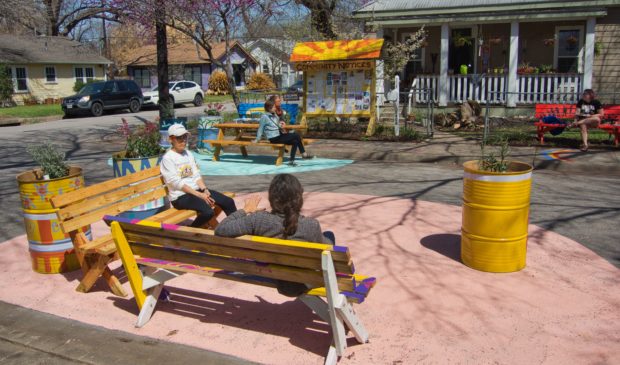Living Streets petition urges city to allow resident-led streetscape changes
Tuesday, July 6, 2021 by
Jonathan Lee Earlier this year, neighbors living along the city’s Healthy Streets – a program that blocked through traffic and slowed cars on selected streets – had an idea: Why not use paint, barrels, picnic tables, and other materials to invite people to gather and play in the street? What followed was “amazing,” Adam Greenfield, president of the advocacy group Walk Austin, told the Austin Monitor.
Along Willow Street in East Cesar Chavez, neighbors used their own supplies to create a “beautiful gathering place where kids were making lemonade on the picnic table, and neighbors were co-working, and new neighbors were walking by and sitting down and just hanging out,” Greenfield said. “It completely changed the dynamic of the street.”
A similar scene arose along Avenue G in Hyde Park, complete with a snow-cone truck. But then, the city came in. Even though the right of way was passable, the city told residents that the installations must be removed. “In both Avenue G and Willow Street, within 24 hours (the city) cleared that stuff out and it was treated as an emergency,” Greenfield said.
Now, Greenfield, along with other advocates and community members, want to make these community-led changes to the streetscape legal with an initiative called Austin Living Streets. “The overall theme of it would be empowering neighbors, residents to shape their own streets using their own materials and city materials where appropriate,” Greenfield said. The initiative is a local example of a global movement to reorganize urban space that has arisen during the pandemic.
The group launched a petition last month urging City Council to adopt several new types of permits:
- A place-making and traffic calming permit, allowing residents to use their own materials to alter the streetscape for a given period of time
- A permit for neighborhood-created play streets to block through traffic and slow cars during designated hours so children can safely play in the street
- A permit to borrow city-owned barricades and signage to be deployed as part of an updated Healthy Streets program
- A daylong block-party permit (current permits are for four hours)
The benefits of such a program, according to Greenfield, include community building, safer streets for all users – children especially – and improved physical and mental health.
According to Greenfield, most of the activities Living Streets proposes are not currently allowed. While the city does have a Neighborhood Block Party Program, according to Greenfield’s analysis, the program’s regulations are excessive compared to those of similar programs elsewhere. “It’s so restrictive that a lot of people just can’t have block parties at all,” he said.
Laura Dierenfield, who works on Healthy Streets at the Austin Transportation Department, responded to the petition in a statement to the Monitor. “Many North American cities, including right here in Austin, have several of the program elements suggested here,” she said, pointing to the block party program and a new phase of Healthy Streets that builds on lessons from the first version.
Dierenfield said ATD looks forward to hearing more about the petition and encouraged residents to share how the Transportation Department can “serve everyone’s needs in the public right of way” through ATX Walk Bike Roll, an initiative to update the city’s Sidewalk, Bikeway and Urban Trails Plan.
The petition also asks Council to carve out money during the August budget process for the program, which should be relatively inexpensive. “We’re not really asking the city to do very much here, we’re basically asking the city to get out of the way and let the community embrace their streets and shape their streets,’” Greenfield said.
Dierenfield noted that city oversight is important to keep streets safe and passable. “Certainly any resident-led initiative in the public right of way needs to consider safety and access first and foremost,” she said, “and permitting processes enable this with requirements for insurance, traffic control and other provisions.”
While Greenfield acknowledged that safety is important, he feels excessive regulation isn’t necessary. “Cities that have a more progressive, open approach to streets have not had problems” with keeping the right of way clear, he said. “They don’t tell (residents) exactly what to do, they just say, ‘bear this in mind and make sure you accommodate for that.’”
City Council, should it consider the program, will have to balance regulation with the primary goal of Living Streets – allowing Austinites to shape their own streets.
This story has been changed since publication to accurately reflect the timing of the placemaking installations.
The Austin Monitor’s work is made possible by donations from the community. Though our reporting covers donors from time to time, we are careful to keep business and editorial efforts separate while maintaining transparency. A complete list of donors is available here, and our code of ethics is explained here.
You're a community leader
And we’re honored you look to us for serious, in-depth news. You know a strong community needs local and dedicated watchdog reporting. We’re here for you and that won’t change. Now will you take the powerful next step and support our nonprofit news organization?



